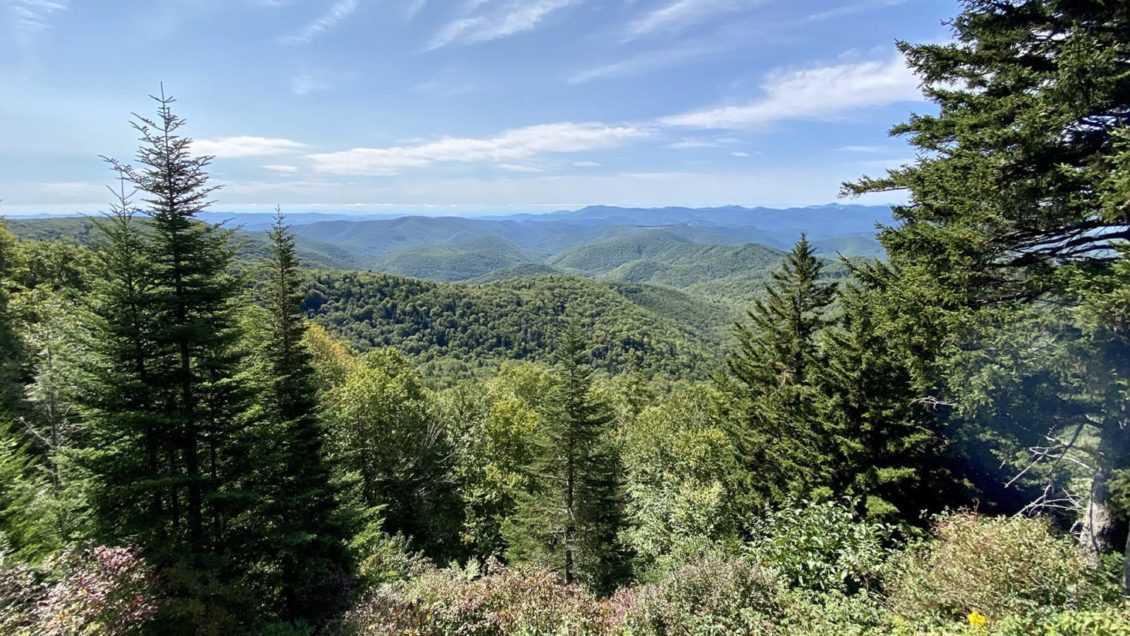The stage is set for a spectacular fall color season in the southern Appalachians thanks to a lack of drought or extreme weather this summer, Clemson University forest ecologist Don Hagan said in his annual fall foliage forecast.

“We had enough rainfall during the summertime where these trees aren’t really going into the fall with much drought stress — but with these cooler temperatures that we have right now, we can expect to start seeing those colors developing pretty quickly over the coming weeks,” said Hagan, who has been making fall foliage predictions for Clemson for eight years.
As Hagan stood on the Courthouse Valley overlook on Sept. 22 — an elevation of 5,365 feet on the first day of fall, with the temperatures barely reaching 50 by midday — he said the first fall colors would develop in the deciduous trees at higher elevations and begin to make their way down the mountain at a rate of roughly 1,000 feet per week.
“At nighttime, we’re probably getting down into the 30s here already — we’ve had a little bit of a cool snap — and that’s exciting because it’s this kind of weather that’s really going to kick off that fall color development,” Hagan said. “Behind me, down in this lower-elevation valley and also some of the peaks around me, beyond the evergreen vegetation, you’ll notice that there’s really not a lot of fall color yet. Everything is still pretty much green, with just a hint of yellow here and there — but it’s coming. It’s going to start changing pretty quickly.”
Hagan said he had been in the same location at the same time in years past and had already seen color beginning to develop by mid-September, but that was typically due to residual summertime drought stress causing these trees to turn early, especially species such as yellow and black birch and yellow-poplar.
“They tend to turn early, especially when it’s a drier year,” Hagan said. “But we’ve had plenty of rainfall this year, all the trees pretty much still have all of their leaves, so I think once those colors really start to change in the coming weeks, you could potentially see a very vibrant palate of colors all across the landscape with that full spectrum all the way from yellow to purple. With these cooler temperatures, that’s going to expedite that fall color and those colors could start developing pretty quickly.”

Hagan said he could foresee a couple potential scenarios playing out. If the temperatures over the coming weeks remain abnormally cool, dipping into the 30s overnight, the fall colors could develop rapidly, building to a typical mid-October peak at the higher elevations. On the other hand, however, there is also the possibility that the development of fall colors could be delayed because 2020 is “a La Niña year.”
A La Niña year, Hagan explained, often manifests itself as average to slightly above-average fall temperatures, which could slow the onset of the fall colors and perhaps even stretch the color season out in terms of duration. But if temperatures stay cool, the fall color season is likely to decrease in duration but increase in variety and vibrancy.
“Warmer temperatures might not necessarily delay the peak of fall colors very much, but it’s going to spread out the timeline, giving you a longer fall color season,” Hagan said. “Either way, though, I think you can expect to see some really, really good fall color this year in the southern Appalachians. It’s going to happen first at these higher elevations and then start spilling on down the mountain — that peak is going to move downhill about 1,000 feet per week — and then you can expect to see good fall color development in places like Upstate South Carolina in late October and early November.”
Some of the first trees where fall color will begin to display itself will be species that turn yellow: the yellow buckeye, for example, has already begun to turn brown and is really the only species Hagan observed that had already begun to turn. Yellow birch and black birch will soon start to show hints of yellow, while other species such as the mountain-ash will also begin to add color to the palette of hues in the coming days and weeks.

Maples will start turning their trademark oranges and reds as October begins, while oaks will join the color parade later in the month of October. Many of the same species exist further down the mountain, where yellow-poplars typically change fairly early into fall weather along with maples, sourwood, dogwoods and other species.
Bright sunny fall days are also critical for fall color development because the bright sunshine helps the development of some of the oranges and reds and purples that give a full spectrum of color to the autumn palette.
“One of the things that makes fall color so spectacular here in the southern Appalachians is the amazing diversity of species — some of the highest diversity of deciduous species anywhere in the world outside of the tropics — and because of that diversity, there’s always that chance that you get that really good fall color season,” Hagan said. “Every species tends to have its own characteristic color and, in a good season, no matter what elevation you are, you could potentially see that full spectrum of fall colors — all the way from yellow to purple, hopefully happening right there at the same time.”
Get in touch and we will connect you with the author or another expert.
Or email us at news@clemson.edu

